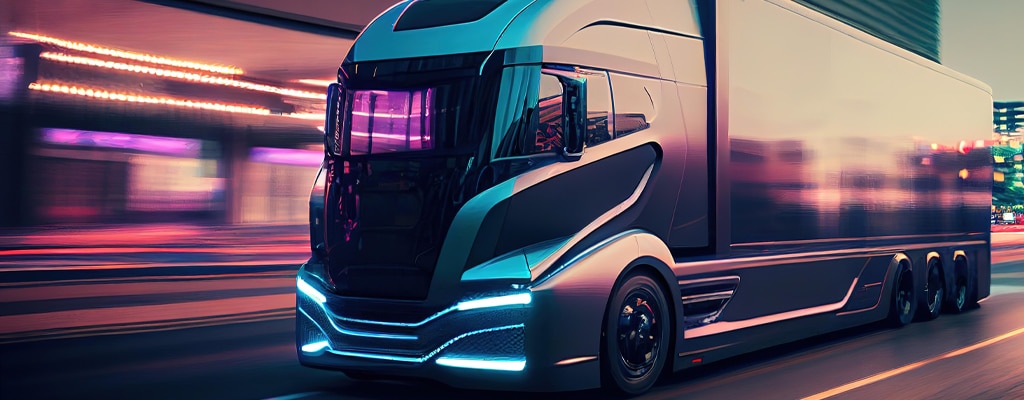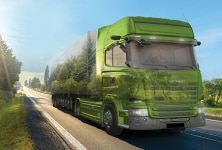
TE Perspectives
The March Toward Commercial Fleet Electrification
Author: Greg Fehribach, VP, Engineering, Transportation Solutions
Transportation is becoming more electric. However, compared to the impressive adoption of electric passenger cars, where EVs now exceed 10% of vehicles sold,[1] the electrification of commercial vehicles might appear to be lagging. However, there has been more movement than you might think in the commercial on-road EV space, even if truck sales have not yet caught up to passenger car sales.
Global sales of commercial electric vans and trucks more than doubled in 2021.[2] As in the passenger car space, manufacturers are unveiling plans for upgraded vehicles in relatively ambitious time frames. As a group, large truckmakers are targeting 35% to 60% of their annual sales to be zero-emission vehicles by 2030.[3]
While the more extended range requirements and heavier weights involved in commercial trucking have delayed EV adoption, commercial EVs enjoy several advantages that passenger EVs did not during their rollout. First, the market demand and the basic technologies needed to produce commercial EVs at scale are better developed, thanks partly to the path passenger EVs have blazed. The off-road commercial market also has seen a substantial uptake of EVs in applications such as mining, yielding insights and technologies that will help accelerate adoption in the on-road space.
Every new advance in EV technology builds on the advances that have come before it. As a result, each new market segment coming online does so without having to solve many of the problems that earlier generations of vehicles encountered. Every day, we see this phenomenon through TE Connectivity’s ongoing work in the passenger and commercial EV markets. From that direct experience, we have identified several upcoming innovations and cross-pollination opportunities that will eventually help EVs gain momentum across the commercial market.

Battery Technology is a Vital Piece of the Puzzle
Battery density remains the primary hurdle to bringing larger, more powerful commercial EVs onto the road. Larger and heavier vehicles require more power to move, which means higher temperatures than passenger EVs. Commercial EV manufacturers must have the proper electrical components to dissipate heat appropriately during charging and operation to ensure vehicles are safe and reliable, especially as battery technology evolves.
Fortunately, advancements in component technology are already making their way into vehicles, making them more efficient than ever. For example, TE’s PowerTube connector series relies on electromagnetic pulse technology to crimp connections, resulting in less resistance and optimized power flow. Its modular and scalable design is just one of many improvements manufacturers can immediately leverage as increasing battery power becomes available. Other technologies developed for durability and higher-power operations in the commercial off-road segment will likely accelerate commercial EV designs.
Because many of these advancements improve the efficiency of both on- and off-road commercial EVs, they are helping to standardize solutions across the industry. This standardization will mean quicker answers for manufacturers electrifying their commercial vehicles—and more cost-effective solutions as these parts get produced at a larger scale.
Some On-Road Segments are Advancing Faster than Others
The commercial on-road EV market is not a monolith, and shorter-haul EVs are much closer to widespread adoption than long-haul fleets. Buses and local hub-and-spoke delivery fleets are ideal applications for today’s battery technology. At the same time, the ability to charge these vehicles periodically at a depot allows fleet operators to take full advantage of today’s battery technology.
Early adopters in these markets are already reaping the benefits of battery-powered fleets. Oil changes are a thing of the past, and their fuel costs are not directly connected to the price of crude oil. Beyond reduced carbon emissions, these vehicles are quieter than conventional buses and trucks, reducing noise pollution. The reduction in moving parts also makes EV power plants easier to maintain – and the ability to use regenerative braking extends the life of brake pads.
Author Interview on Electrifying Commercial Fleets
Long-Haul Remains the Final Frontier
Beyond greater battery density, long-haul EVs face additional technical challenges that the industry must solve to enable broad adoption. For example, the longer wheelbase of tractor-trailers requires manufacturers to move energy farther from the battery to the wheel. Therefore, ensuring the wires and connections can reliably deliver that power efficiently and safely is critical.
Trailer-to-tractor connections present another challenge because of the number of times they need to be plugged and unplugged over their lifetime. Passenger EVs generally don’t require connections built to withstand numerous mating cycles. Commercial trailers need a tight connection that can transfer energy efficiently and withstand constant disconnections and reconnections, as well as the heavy vibration experienced during long-haul trips. TE is looking into zero-force insertion models and other potential technologies to address this issue.
The industry will also need widespread charging infrastructure upgrades to ensure that long-haul EVs can get from one charging station to another and recharge rapidly to meet delivery schedules. Producing that volume of electricity and moving it across the grid will require additional innovation and investment in electric infrastructure to support expanded EV fleets across all segments of commercial trucking.
However, long-haul fleets don’t need to jump directly to EVs to improve their sustainability profile. As the industry waits for improved battery density and more robust charging infrastructure, hybrid solutions will become increasingly available to commercial long-haul fleet operators. TE already produces high voltage connectors and wiring harnesses needed to integrate the battery portion of a hybrid vehicle with its conventional engine.
An Electric Future for Commercial Vehicles May Be Closer than You Think
Continued advances in EV technology are generating momentum in commercial vehicle electrification. We expect more in-town hub-and-spoke EV fleets to roll out over the next two to five years. For long-haul applications, hybrid vehicles are likely to increase in number as battery and charging technologies continue to evolve over the next decade or so.
In the meantime, TE is looking to the future and preparing to support further technological changes. In addition to developing components that move electricity as efficiently as possible from batteries to wheels, we’re paying close attention to elements such as shielding so EV power systems can operate without disrupting other systems. Data communication cables also will be critical to support the remote cameras needed to advance semi-autonomous and eventually fully autonomous vehicles, yielding additional safety and efficiency gains for fleet operators.
These longer-term advancements will build on the robust foundation already established for today’s passenger and off-road EVs. As components become more advanced and batteries become more powerful, electrification will take hold rapidly across all segments of the commercial EV marketplace.
About the Author

Greg Fehribach
Greg Fehribach is the vice president, Engineering for TE’s Transportation Solutions segment. In this role, he is responsible for the strategic direction of global engineering, product research, and innovation for on and off-highway commercial applications. Prior to his current role, Greg served as CTO for TE’s Commercial and Industrial Transportation division and as CTO for TE’s Application Tooling division. He previously held a number of senior leadership roles at Cummins Inc. Greg holds a Master of Mechanical Engineering degree from the University of Louisville as well as an MBE from Indiana University.
Insights on Innovation in Transportation Technology
More Stories on Tech Innovation


 e
e
 e
e
 e
e


